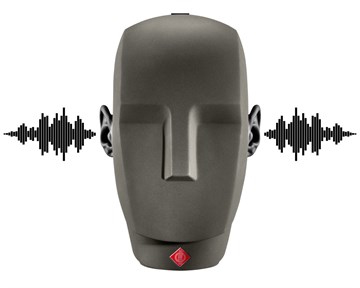Binaural Stereo Synthesizers and Multitracking
Exploring binaural stereo implementations in synthesizers
 Binaural Basics
Binaural Basics
Binaural, in terms of synthesizer implementation, has a bit of greyscale in its interpretation. Technically, in terms of synthesizers, it may be better described as stereophonic, however many manufacturers and the general public often use the term binaural. The essence of "binaural sound" is that when listening with headphones, or with a good stereo monitoring setup with appropriate positioning, it bathes the listener in a stereo sound field where small differences between the left/right channels/ears creates the impression of the sound source not having a single stable location, but rather coming from multiple directions, or having some sort of movement in the space around the listener.
The Pedantic Definition of Binaural
For a more pedantic, technical definition - If you were recording live content with two microphones to be binaurally re-transmitted, you would set up two mics that are at about ear distance apart, and then record your environment. Then, when broadcast later (through headphones preferably), the listener would hear the same tiny differences in amplitude and phasing between the left and right ear, to be able to "hear the environment in 3D".
Comparison with Multi-Tracking
Another interesting thing to consider is the idea of "multitracking" an instrument part. This is a recording technique that is often used in a variety of genres, where you record a guitar, keyboard, vocal or other part twice (or more), and hard pan the tracks left and right. The same content/harmony/melody is played on both right and left, but small differences in the musician's performance creates this wide, stereophonic/binaural effect when the listener hears it. Instead of coming from a single source, the sound of the multitracked guitars/keyboards/vocals becomes all-encompassing, and small amounts of phasing may even create the sense of motion around the listener. So, to me, Multitracking with hard panning is just another example of the same type of effect. Creating binaural effects with synthesizers is almost like multitracking your keyboard parts, in real-time.
Methods of Achieving Binaural or Stereophonic Sound Fields with Synthesizers
Some synthesizers offer multiple filters and amp sections per voice, and you can mix your oscillators into the filter and amp sections, then hard pan each filter/amp left or right. The Dave Smith Evolver line of synths offers a sort of hidden extra filter and amp in its architecture, where two oscillators are routed to one filter/amp section and the other two oscillators are routed to the other filter/amp section. In the case of the Evolver, these filters and amps are identical in design, and controlled by the same panel knobs. When you set the Pan Mode on the evolver to separate these two sections hard left and hard right, you are immediately presented with this sort of binarual stereo field of sound.
Even though the settings between the layers may be nearly identical, the tiny differences in electrical tolerances can cause a small amount of phasing between left and right channels, resulting in the listener hearing the sounds as more multi-directional, or with movement. If you slightly adjust the fine tuning of oscillators, or modulate the filter or panning with LFOs in this mode, the binaural stereo separation widens, creating an all encompasing sound. In addition to the Evolver, there are several other instruments that have multiple different filters that can be routed dependantly, like the Arturia MatrixBrute and upcoming PolyBrute, which can be set up to acheive a similar type of sound. The UDO Super 6 is another example of a synth where voices are purposefully split to separate filters to create this binaural effect.
Using Bitimbral Synth to Achieve Stereophonic/Binaural Sounds:
For modern synths that offer multi-timbrality (bi-timbral or better), you can Stack/Layer two identical (or nearly identical) layers of a patch, and then hard pan each layer left and right. With the Prophet Rev2 and other modern bi-timbral synths, this is fairly easy to setup with a few actions and routing a single mod slot to panning on each layer. In this configuration of stacked and panned layers, even with no parameter changes between the layers, you will hear the stereo, binarual effect. Then, to emphasize the effect, and widen the stereo field, you can make tiny adjustments to oscillator fine tunings, filter cutoff, and envelope stage timing. Each little change will add up and create natural phasing in the stereo field, and you can quickly turn a pedestrian string sound, into the sound of a wide orchestral section of string players.
On Prophet Rev2,
1. Create a single layer sound design.
2. Copy Layer A to Layer B, so you have two exact copies of that sound.
3. On Both Layers, set Pan Mode to "Fixed"
4. On Layer A, set a Mod Slot to: DC -> VCA Pan, Amount -32
5. On Layer B, set a Mod Slot to: DC -> VCA Pan, Amount +32
6. Stack the Layers
7. Emphasize the Stereophonic/Binaural effect, by making some microadjustments to tunings, filter, envelopes or other parameters.
In the below video, at about 23:30, you can see an example of using the stacked, hard pan effect to create a stereophonic/binaural sound:
And here's a video by Peter Dyer, showing off binaural sounds on the Rev2: